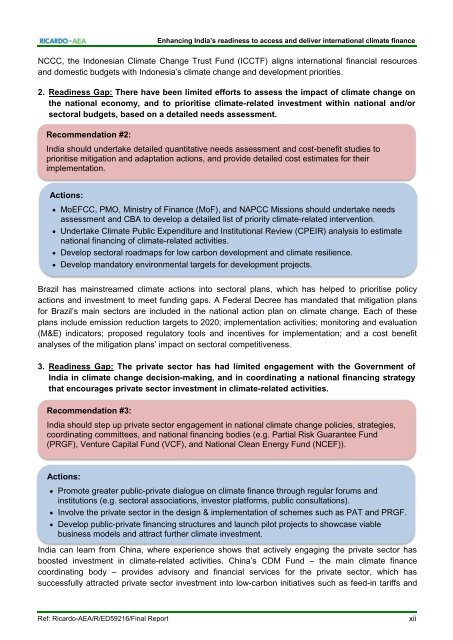Enhancing India’s Readiness to Climate Finance
India has taken several steps to improve its national response to climate change. India’s climate finance requirements, however, are very high, and will need to be met through a combination of public, private and international climate finance. See more at: http://shaktifoundation.in/
India has taken several steps to improve its national response to climate change. India’s climate finance requirements, however, are very high, and will need to be met through a combination of public, private and international climate finance. See more at: http://shaktifoundation.in/
- No tags were found...
You also want an ePaper? Increase the reach of your titles
YUMPU automatically turns print PDFs into web optimized ePapers that Google loves.
<strong>Enhancing</strong> <strong>India’s</strong> readiness <strong>to</strong> access and deliver international climate finance<br />
NCCC, the Indonesian <strong>Climate</strong> Change Trust Fund (ICCTF) aligns international financial resources<br />
and domestic budgets with Indonesia’s climate change and development priorities.<br />
2. <strong>Readiness</strong> Gap: There have been limited efforts <strong>to</strong> assess the impact of climate change on<br />
the national economy, and <strong>to</strong> prioritise climate-related investment within national and/or<br />
sec<strong>to</strong>ral budgets, based on a detailed needs assessment.<br />
Recommendation #2:<br />
India should undertake detailed quantitative needs assessment and cost-benefit studies <strong>to</strong><br />
prioritise mitigation and adaptation actions, and provide detailed cost estimates for their<br />
implementation.<br />
Actions:<br />
MoEFCC, PMO, Ministry of <strong>Finance</strong> (MoF), and NAPCC Missions should undertake needs<br />
assessment and CBA <strong>to</strong> develop a detailed list of priority climate-related intervention.<br />
Undertake <strong>Climate</strong> Public Expenditure and Institutional Review (CPEIR) analysis <strong>to</strong> estimate<br />
national financing of climate-related activities.<br />
Develop sec<strong>to</strong>ral roadmaps for low carbon development and climate resilience.<br />
Develop manda<strong>to</strong>ry environmental targets for development projects.<br />
Brazil has mainstreamed climate actions in<strong>to</strong> sec<strong>to</strong>ral plans, which has helped <strong>to</strong> prioritise policy<br />
actions and investment <strong>to</strong> meet funding gaps. A Federal Decree has mandated that mitigation plans<br />
for Brazil’s main sec<strong>to</strong>rs are included in the national action plan on climate change. Each of these<br />
plans include emission reduction targets <strong>to</strong> 2020; implementation activities; moni<strong>to</strong>ring and evaluation<br />
(M&E) indica<strong>to</strong>rs; proposed regula<strong>to</strong>ry <strong>to</strong>ols and incentives for implementation; and a cost benefit<br />
analyses of the mitigation plans’ impact on sec<strong>to</strong>ral competitiveness.<br />
3. <strong>Readiness</strong> Gap: The private sec<strong>to</strong>r has had limited engagement with the Government of<br />
India in climate change decision-making, and in coordinating a national financing strategy<br />
that encourages private sec<strong>to</strong>r investment in climate-related activities.<br />
Recommendation #3:<br />
India should step up private sec<strong>to</strong>r engagement in national climate change policies, strategies,<br />
coordinating committees, and national financing bodies (e.g. Partial Risk Guarantee Fund<br />
(PRGF), Venture Capital Fund (VCF), and National Clean Energy Fund (NCEF)).<br />
Actions:<br />
Promote greater public-private dialogue on climate finance through regular forums and<br />
institutions (e.g. sec<strong>to</strong>ral associations, inves<strong>to</strong>r platforms, public consultations).<br />
Involve the private sec<strong>to</strong>r in the design & implementation of schemes such as PAT and PRGF.<br />
Develop public-private financing structures and launch pilot projects <strong>to</strong> showcase viable<br />
business models and attract further climate investment.<br />
India can learn from China, where experience shows that actively engaging the private sec<strong>to</strong>r has<br />
boosted investment in climate-related activities. China’s CDM Fund – the main climate finance<br />
coordinating body – provides advisory and financial services for the private sec<strong>to</strong>r, which has<br />
successfully attracted private sec<strong>to</strong>r investment in<strong>to</strong> low-carbon initiatives such as feed-in tariffs and<br />
Ref: Ricardo-AEA/R/ED59216/Final Report<br />
xii

















